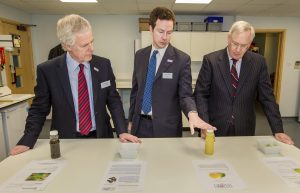Since the global financial crisis, the container shipping industry has been plagued with government bail-outs, huge corporate losses, and an ever expanding fleet of mega vessels. But the 2016 collapse of South Korea’s Hanjin Shipping, seemingly triggered a new era of reform across the container shipping industry. Nevertheless, critics reflect on a conservative, even archaic, industry which has been too slow to modernize and adapt to change, and wonder if we are really witnessing a ground zero moment when the tide is at last turning and shipping lines can begin to claw their way back to profitability after years of losses. Or have those operators who made such heavy weather of their recovery from the financial crisis of 2008 still not regained full control of the levers they will need to see them through the coming storms which undoubtedly lie ahead?
Here Peter West who is the Director of the supply chain and logistics company Maia Global, brings Fruit Juice Focus up-to-date with the latest changes in the container shipping industry, recent problems and the likely impact on the international trade of fruit juice products.
The new container shipping landscape
In addition to the shockwave of the Hanjin bankruptcy, several rounds of mergers and acquisitions have seemingly created a new order in the shipping community: Maersk Line have bought the family-owned Hamburg Süd, CMA CGM have secured the NOL Group, Hapag Lloyd have acquired UASC, to mention just a few of the recent realignments.
Even more importantly, this has prompted the introduction of three new mega alliances designed to achieve economies of scale, address the excess capacity problems and maintain more sustainable freight rates – all problems that have constantly dogged the industry. These mega alliances will now line up as follows:
- 2M (32.3%): Maersk (18.5%) & MSC (13.8%)
- Ocean Alliance (26.1%): CGM CMA (10.5%), COSCO (8.0%), Evergreen (4.8%) & OOCL (2.8%)
- The Alliance (16.4%): Hapag Lloyd (7.1%), Yang Ming (2.8%) & the Japanese carriers 1 (6.5%)
The Alphaliner Top 100 2 shows that the container shipping industry still regards itself as very fragmented, with the main carrier still only controlling 18% of the market and the top five controlling a total of 58%. However, further analysis of the cumulative capacities of above-mentioned carriers, shows they control 75% of overall capacity, with the remaining 25% handled by niche carriers on smaller trades. Using those numbers, it means that the number one carrier Maersk Line controls approximately 25% of market capacity and the whole 2M alliance commands 43%.
Despite all this seemingly positive news for the container shipping industry and ever-increasing geopolitical features such as regional trade wars, the escalating risk of terrorism, and growing legislative burdens, it remains vital that the global container shipping industry persist with its transformative initiatives.
Recent changes to carrier services in Europe and the effects on juice producers and customers
From March to May this year the carriers have been implementing the changes to services and rotation as the new alliances come into force, with shipments from Europe being heavily impacted as a result. Space then became an issue for the hub ports as the backlog built up. For example, we have seen containers of juice that have sat at the hub ports for more than 35 days – which is unheard of. In my whole experience of the industry I have not seen containers purposely miss more than two.
The problem hasn’t stopped there. When the containers finally get shipped and arrive at their destinations they have been unrefrigerated for more than five in transit in direct sunlight which raises the issue of potential spoilage of the juice and the compensation and insurance issues. You then have the situation where there has been a shortage for those past five weeks because there is no supply coming in which in turn means that the customers have had to scramble to get other supplies from elsewhere. When the containers finally arrive they inevitably end up with far too much stock.
The outlook for customers in the fruit juice trade
Life is no easier for customers in such an uncertain environment where service contract priorities seem to dictate that choosing a carrier who will still be trading in a years’ time is arguably more important than sourcing the lowest freight rates.
However, seemingly unnerved by the market volatility, exporters and importers are increasingly adopting short-term pricing strategies, effectively gambling on container spot rates in the hope that the market may soon revert to back its downward trend. So, when recommended to lock in rates and commitments for 2017, a customer will invariably ask: ‘But what if rates go down?’ This is the wrong perspective in the current climate because, whilst occasional falls can never be ruled out, the real risk is that substantial increases are much more likely.
The general effect of industry restructuring has been to limit carrier options and services. So with the newly consolidated carriers now inclined to be much more cautious and inflexible, freight forwarders are trying to fill the void by leveraging their global relationships to make life somewhat easier for customers.
All these factors influence market behaviours and can be illustrated by referencing some of these effects on two major trade juice trade lanes:
China to US
The transpacific trade lane from China, carries around 67% of all imported Apple Juice Concentrate to the USA 3. In a sector where packaging and logistics can make up as much as 35% of the delivered cost, managing these spikes will be key to maintaining profitability.
Rate volatility on this trade lane can be demonstrated by looking at the price movements over the past 5 years for dry containers from China bound for the USEC. Average prices in 2012 were USD2500/20’, bottomed at USD550/20’ in 2016, rose sharply to above USD2500/20’ in the wake of the Hanjin failure, and are now hovering around USD1900/20’.
The apple juice producing season clashes with the retail peak seasons moving on this trade lane. So with the transpacific peak season approaching, it is expected that shipping rates will continue an upward trend over the next two quarters.
Brazil to Europe
The South American trade lanes have always been the traditional preserve of major carriers such as Maersk Line and Hamburg Süd. JOC.com estimated in a recent study that if Maersk is successful in acquiring all of Hamburg Süd’s assets, the new conglomerate could control as much as 80% of the market on some major trade lanes from South America 4.
Rate movements on the Santos to Rotterdam trade lane for refrigerated containers dropped from USD3200/40’ in 2012, bottomed at USD1450/40’ in 2016 and since then, have been recovering slowly having now reached around USD1900/40’. Now the Southern hemisphere growing season is well underway, and with the Brazilian orange juice production season starting this May in Sao Paulo state, we expect rates on these lanes to continue an upward trajectory for at least the next 6-12 months.
Future implications
With industry consolidation well underway, plus a raft of changes in carrier services, the expectation is that carriers are set to remain in the driver’s seat for the foreseeable future. Viewed objectively, available capacity has not reduced but has instead increased, even though the locus of control is now very much in the hands of a few. As these carriers push to increase rates, keep their vessels full and meet new rotations, it seems very likely that the second half of 2017 will precipitate a significant increase in rates – a bloodbath which may once again test the industry’s resilience. Expect many exporters and importers to adopt tactics such as desperate, ad hoc pricing strategies and increasing safety stocks in response to price instability and uncertainty surrounding service performance.
But over the next 2-3 years, rates will again stablise and return to levels at or below the current market. Major trade lanes will be serviced by larger and more economical vessels, bunkering costs are likely to remain at or around their present low levels, and the overall service costs will correspondingly decrease. The recent expansion of the Panama Canal has at last opened this ocean corridor allowing larger vessels from Asia to gain greater access to the US East Coast, which should lead to a long-term reduction in the East vs. West Coast rate differential. And the world will return to normal, if such a term exists anymore.









